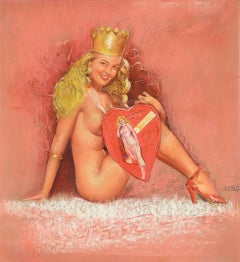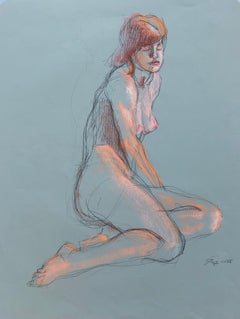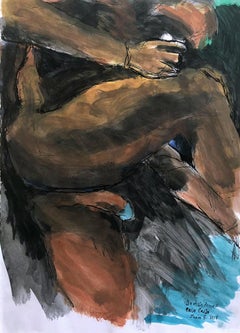Earl MacPherson Art
to
1
1
1
1
Overall Height
to
Overall Width
to
1
1
1
1
1
1
1
6,935
3,285
2,514
1,213
1
1
1
Artist: Earl MacPherson
"I Love You" Pin-Up, 1952
By Earl MacPherson
Located in Fort Washington, PA
Medium: Pastel and Collage on Paper
Signature: Signed Lower Center and Dated Lower Right
Framed dimensions: 30.00" x 27.00"
Category
1950s Earl MacPherson Art
Materials
Pastel, Paper
Related Items
Woman at Rest, Nude Female, Pastel and Charcoal Drawing on Green Paper
By Christopher Ganz
Located in Chicago, IL
The loose style of this drawing comes together quickly to convey the relaxed state of this nude female. The pastel accents bring a beautiful warmth to this drawing.
Christopher Ganz
Woman at Rest, 2013
pastel and charcoal on green paper
23h x 18w in
58.42h x 45.72w cm
CG0062
-ARTIST STATEMENT-
I depict my person in multiplicity with different selves representing dramatis
personae. My likeness is both implicit and symbolic in the portrayal of my
narrative; the drama involved in creating art and the artist’s role in society. I
use realism to invite the viewer into mysterious inner worlds that are layered
reflections of the outer. Dehumanizing environments are imbued with art
historical references as a critique of power structures. The artist is an
Everyman who is at odds with society and his self.
Visually my work is a celebration of society’s dark undercurrents and its
overlooked absurdities. I use charcoal and printmaking media as their
tenebrous values add a fitting metaphor. The nuances of light and shadow
seduce viewers into a world their better judgment would have them avoid.
This provokes a sense of disquietude that causes viewers to assess our world
through the austerity of a colorless, yet not humorless, light.
-BIO-
Christopher Ganz grew up in Northeast Ohio and from early on had a fertile imagination and an interest in art. Christopher's artistic education truly began at the University of Missouri, where his love of the human form led to many figure drawing classes and his exposure to the wonders of printmaking. Christopher's then went onto graduate school at Indiana University and a summer abroad program in Italy was a dream realized. Christopher then grasped charcoal with a renewed vigor and large, sfumato-laden drawings ensued. Christopher's artistic influences are many; from a seminal exposure to Dore's engravings of the Divine Comedy, to Rembrandt, Caravaggio, Goya, and up to Lucian Freud, Mark Tansey...
Category
21st Century and Contemporary Contemporary Earl MacPherson Art
Materials
Charcoal, Paper, Pastel
H 23 in W 18 in D 0.1 in
"Duchándome, June 5th", Watercolor Nude, Pastel and Ink on Archival Paper
By Celso José Castro Daza
Located in Miami Beach, FL
"Duchándome June 5th" by Celso Castro-Daza
From the Duchándome Series
Watercolor, pastel, and ink on archival paper
Sheet size: 19.5 in. H x 13.75 in. W
2018
Drawing on paper is ...
Category
2010s Contemporary Earl MacPherson Art
Materials
Pastel, Archival Ink, Watercolor, Archival Paper
H 19.5 in W 13.75 in D 0.1 in
Duchándome. Nude watercolor on paper
By Celso José Castro Daza
Located in Miami Beach, FL
Duchándome, by Celso Castro
From the Duchándome Series
Watercolor, ink, and pastel archival paper. NUDES 2D
Individual size: 19.5 in. H x 13.75 in. W
2018
Drawing on paper is his basic work tool, some are sketches of his surviving works, and others are sketches of moments he documents.
____________
Undefined by medium, Celso Castro’s works each carry the presence of the artist’s hand through the transparency of their process. Castro’s oeuvre is strongly divided between his photomontage assemblies and watercolor paintings: the prior is marked by the labor-intensive deconstruction of portrait photographs and the latter, by the seemingly frenzied recreation of a past encounter rendered in the drips and scribbles of paint and ink. Both discriminating in what they reveal of the subject, his photomontage and watercolor portraits exude raw sexuality through the combination of Castro’s mark-making and gaze. Celso Castro’s work is a bare-bulb erotic photo...
Category
2010s Contemporary Earl MacPherson Art
Materials
Pastel, Archival Ink, Watercolor, Archival Paper
French Mid Century Picasso Influenced Zoomorphic Female Nude
Located in Cotignac, FR
French Mid Century Picasso Influenced stylised zoomorphic female nude drawing, oil crayon on paper, Paris School, signed and dated 1963. The work is presented in a chrome period fram...
Category
1960s Modern Earl MacPherson Art
Materials
Oil Crayon, Paper, Pastel
Jose antonio, Martes 7 de julio, Figurative painting
By Celso José Castro Daza
Located in Miami Beach, FL
Jose antonio, Martes 7 de julio 2016, by Celso Castro
Crayon Pastel on archival paper
Image size: 60 H in. x 38 in. W
Unframed
On The back of the painting:
Abstract, 1986
Pencil a...
Category
1990s Contemporary Earl MacPherson Art
Materials
Pastel, Crayon, Archival Paper
H 60 in W 38 in D 0.1 in
Recanato y compañero, viernes 3 de junio 2016, Drawing
By Celso José Castro Daza
Located in Miami Beach, FL
Recanato y compañero, viernes 3 de junio 2016, by Celso Castro
Crayon Pastel on archival paper
Image size: 59 H in. x 39.5 in. W
On the back of the painting:
Untitled, 1986
Crayon...
Category
1990s Contemporary Earl MacPherson Art
Materials
Archival Paper, Crayon, Pastel
H 59 in W 39.5 in D 0.1 in
Pity June 4th. Nude watercolor on paper
By Celso José Castro Daza
Located in Miami Beach, FL
Pity, June 4th by Celso Castro
From the Duchándome Series
Watercolor, ink, and pastel archival paper.
Image size: 19.5 in. H x 13.75 in. W
2018
____________
Undefined by medium, Celso Castro’s works each carry the presence of the artist’s hand through the transparency of their process. Castro’s oeuvre is strongly divided between his photomontage assemblies and watercolor paintings: the prior is marked by the labor-intensive deconstruction of portrait photographs and the latter, by the seemingly frenzied recreation of a past encounter rendered in the drips and scribbles of paint and ink. Both discriminating in what they reveal of the subject, his photomontage and watercolor portraits exude raw sexuality through the combination of Castro’s mark-making and gaze. Celso Castro’s work is a bare-bulb erotic photo...
Category
2010s Contemporary Earl MacPherson Art
Materials
Pastel, Archival Ink, Watercolor, Archival Paper
Untitled, Figurative Drawing
By Celso José Castro Daza
Located in Miami Beach, FL
Untitled, 1986 Diptych Reverse, by Celso Castro Daza
Crayon on archival paper
Image size: 39.5 H in. x 59 in. W
On the back of the painting:
Recanato y compañero, viernes 3 de juni...
Category
1990s Contemporary Earl MacPherson Art
Materials
Pastel, Crayon, Archival Paper
Futurist, Novecento Italiano, Mid Century Italian Painting, Figures at the Baths
By Anselmo Bucci
Located in Cotignac, FR
Mid 20th Century Italian Futurist, Novecento Italiano, work on paper, signed bottom right and with dedication top right (see photos).
The subject is bathers enjoying the delights of a spa and sauna with colourful tiling to the background. The classical figures languorously positioned in repose but the central 'white' figure in stark contrast. The play on colours gives the work a vibrancy. The drawing is possibly a preparatory sketch for a larger work or mural.
A vibrant, exciting and colourful work incorporating the styles of Futurism and the Novecento Italiano movement and with the influences or artists such as Anselmo Bucci, Adami, Jean Helion, Maryan, Achille Funi and Ugo Guidi.
Anselmo Bucci was born in 1887 in Fossombrone in the district of Pesaro. Even though he studied Classics, right from a tender age he showed a talent for drawing and, when his parents moved near to Florence, he was taught by the artist Francesco Salvini.
In 1904 the family settled in Monza and so the boy was able to study for a year at the Accademia di Belle Arti di Brera, but he did not follow up this educational experience and in 1906 he left Italy for Paris where he came into contact with the Parisian avant-garde, met fellow Italian artists such as Severini and Modigliani, and made friends with Picasso, Utrillo and Apollinaire. In 1907 he showed a painting at the Salon, but these Parisian years were most important for his love of engraving techniques – etching and dry point that enabled him to fully develop his themes characterised by movement.
On the outbreak of war in 1915 he returned to Italy and he enlisted in the same battalion as several Futurist artists such as Martinetti, Boccioni, Sant’Elia and Carlo Erba. In 1914 he won the silver medal at the Mostra dell’Incisione (Exhibition of Engravings) at Florence. In 1917 in Paris he published pictures of war scenes entitled “Croquis du Front Italien”. In 1919 he printed twelve lithographs entitled “Finis Austriae” again showing events from the war. At the end of the war he lived between Milan and Paris and he dedicated his time completely to his art with personal exhibitions, exhibiting at all the most important Italian and French shows, in Belgium, Holland and England.
In 1922, he established the group “Movimento del Novecento”, (Novecento Italiano), (20th century Movement) a joint venture with the artists Sironi, Funi, Oppi, Malerba, Dudreville and Marussig. Their aim was to return to figurative art in contrast with the growing extremism of the Avant-gardists. In 1925 he worked on the illustration of the first edition of Kipling’s The Jungle Book producing eight dry point plates.
In the early 30’s he lived in Bucci, Trieste, where he worked on the furnishing of the steamships for the Trieste Navigazione Libera, at the same time he continued to work on many book illustrations.
During the second European war he adapted to being a war artist recording the events of the war as he had done previously. Indeed the engravings depicting battles of the Marines and the Air Force belong to this period. In 1945, following the bombing of his house in Milan, he returned to Monza to his father’s home where he remained until his death.
Futurism was an Italian art movement of the early twentieth century that aimed to capture in art the dynamism and energy of the modern world. Futurism was launched by the Italian poet Filippo Tommaso Marinetti in 1909. On 20 February he published his Manifesto of Futurism on the front page of the Paris newspaper Le Figaro.
Among modernist movements futurism was exceptionally vehement in its denunciation of the past. This was because in Italy the weight of past culture was felt as particularly oppressive. In the Manifesto, Marinetti asserted that ‘we will free Italy from her innumerable museums which cover her like countless cemeteries’. What the futurists proposed instead was an art that celebrated the modern world of industry and technology:
We declare…a new beauty, the beauty of speed. A racing motor car…is more beautiful than the Victory of Samothrace. (A celebrated ancient Greek sculpture in the Louvre museum in Paris.)
Futurist painting used elements of neo-impressionism and cubism to create compositions that expressed the idea of the dynamism, the energy and movement, of modern life.
Chief artists associated with futurism were Giacomo Balla, Umberto Boccioni, Gino Severini.
After the brutality of the first world war, many artists rejected the avant-garde notions of futurism and other pre-war movements, by using more traditional and reassuring approaches, a phenomenon described as the ‘return to order’.
Novecento Italiano was founded by Anselmo Bucci (1887–1955), Leonardo Dudreville (1885–1975), Achille Funi, Gian Emilio Malerba (1880–1926), Pietro Marussig, Ubaldo Oppi, and Mario Sironi. Motivated by a post-war "call to order", they were brought together by Lino Pesaro, a gallery owner interested in modern art, and Margherita Sarfatti, a writer and art critic who worked on Italian dictator Benito Mussolini's newspaper, The People of Italy (Il Popolo d'Italia). Sarfatti was also Mussolini's mistress.
The movement was officially launched in 1923 at an exhibition in Milan, with Mussolini as one of the speakers. The group was represented at the Venice Biennale of 1924 in a gallery of its own, with the exception of Oppi, who exhibited in a separate gallery. Oppi's defection caused him to be ejected from the group, which subsequently split and was reformed. The new Novecento Italiano staged its first group exhibition in Milan in 1926.
Several of the artists were war veterans; Sarfatti had lost a son in the war. The group wished to take on the Italian establishment and create an art associated with the rhetoric of fascism. The artists supported the fascist regime and their work became associated with the state propaganda department, although Mussolini reprimanded Sarfatti for using his name and the name of fascism to promote Novecento.
The name of the movement (which means 1900s) was a deliberate reference to great periods of Italian art in the past, the Quattrocento and Cinquecento (1400s and 1500s). The group rejected European avant garde art and wished to revive the tradition of large format history painting in the classical manner. It lacked a precise artistic programme and included artists of different styles and temperament, for example, Carrà and Marini. It aimed to promote a renewed yet traditional Italian art. Sironi said, “if we look at the painters of the second half of the 19th century, we find that only the revolutionary were great and that the greatest were the most revolutionary”; the artists of Novecento Italiano “would not imitate the world created by God but would be inspired by it”.
Despite official patronage, Novecento art did not always have an easy ride in Fascist Italy. Mussolini was personally uninterested in art and divided official support among various groups so as to keep artists on the side of the regime. Opening the exhibition of Novecento art in 1923 he declared that “it is far from my idea to encourage anything like a state art. Art belongs to the domain of the individual. The state has only one duty: not to undermine art, to provide humane conditions for artists, to encourage them from the artistic and national point of view." The movement was in competition with other pro-Fascist movements, especially Futurism and the regionalist Strapaese movement. Novecento Italiano also met outright opposition. Achille Starace, the General Secretary of the Fascist Party, attacked it in the Fascist daily press and there was virulent criticism of its “un-Italian" qualities by artists and critics.
In the 1930s, a group of professors and students at the Accademia di Brera established an opposition group to Novecento Italiano. Among them was the director of the academy Aldo Carpi, and students Afro, Aldo Badoli, Aldo Bergolli, Renato Birolli, Bruno Cassinari, Cherchi, Alfredo Chighine, Grosso, Renato Guttuso, Dino Lanaro, Giuseppe Migneco, Mantica, Ennio Morlotti, Aligi Sassu, Ernesto Treccani, Italo Valenti, and Emilio Vedova (and later Giuseppe Ajmone...
Category
Mid-20th Century Futurist Earl MacPherson Art
Materials
Paper, Pastel, Crayon, Pencil
H 31.5 in W 43 in D 0.25 in
From the Duchándome, Nudes Series. Set of 4 Watercolors on archival paper
By Celso José Castro Daza
Located in Miami Beach, FL
Duchándome and Pity June 4th, by Celso Castro-Daza
From the Duchándome Series
Watercolor, ink, and pastel on archival paper.
1. Duchándome
2. Pensando & recordando a Luis Caballero...
Category
2010s Contemporary Earl MacPherson Art
Materials
Pastel, Archival Ink, Watercolor, Archival Paper
H 39 in W 27.5 in D 0.1 in
"Paola I", Nude Drawing by Franco Fusari
By Gianfranco Franco Fusari
Located in Long Island City, NY
Artist: Franco Fusari, Italian (1945 - )
Title: Paola I
Year: 2009
Medium: Conte Pastel on Paper, signed
Size: 14 in. x 19.3 in. (35.56 cm x 49.02 cm)
Frame Size: 22.5 x 30 inches
Category
Early 2000s Realist Earl MacPherson Art
Materials
Paper, Pastel
Two Balinese Beauties (Mapeed), circa 1945
By Johan Rudolf Bonnet
Located in Amsterdam, NL
Rudolf Bonnet (1895-1978)
'Mepèèd' (Mapeed)
Signed lower right
Titled upper right
Pastel on gouache pigmented paper, 57 x 34 cm
In original carved ebo...
Category
1940s Earl MacPherson Art
Materials
Crayon, Paper, Pastel, Gouache, Pencil
Free Shipping
H 22.45 in W 13.39 in D 0.04 in
Earl Macpherson art for sale on 1stDibs.
Find a wide variety of authentic Earl MacPherson art available for sale on 1stDibs. If you’re browsing the collection of art to introduce a pop of color in a neutral corner of your living room or bedroom, you can find work that includes elements of orange and other colors. You can also browse by medium to find art by Earl MacPherson in crayon, paper, pastel and more. Not every interior allows for large Earl MacPherson art, so small editions measuring 20 inches across are available. Customers who are interested in this artist might also find the work of Victor Di Gesu, Michael Loew, and Janet Ament De La Roche. Earl MacPherson art prices can differ depending upon medium, time period and other attributes. On 1stDibs, the price for these items starts at $5,500 and tops out at $5,500, while the average work can sell for $5,500.


